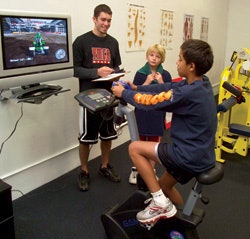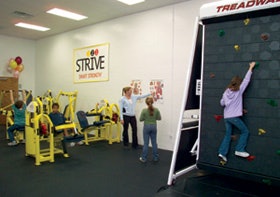Successful fitness programs for the increasingly integral 8- to 13-year-old demographic rely on three key components.

The boy's confidence soared, his grades improved and he told his friends about the training sessions. Soon, Hanson developed a special class for the boy and seven of his closest friends, offering their parents a group rate for 60-minute cardiovascular-fitness and strength-training sessions involving medicine balls, plyometrics and martial arts. "It has exploded since then," Hanson says. "Before I knew it, I was teaching 50 kids."
Hanson is not alone. In recent years, health clubs and YMCAs from coast to coast have bolstered their programming for so-called "tweens," a pre-teen demographic often defined as kids between the ages of 8 and 13. And it's a demographic worth targeting. According to the U.S. Centers for Disease Control and Prevention, more than 60 percent of all children between the ages of 9 and 13 engage in no organized physical activity outside of school. Even more alarming: 23 percent of children in that age group participate in no free-time physical activity either.
Tween programming is not always a big moneymaker, however, and it's certainly not as routine as adult programming. Prairie Athletic Club in Sun Prairie, Wis., struggled to consistently offer its "Youth Circuit" training class for 7- to 12-year-olds until administrators could find an instructor who knew how to work effectively with kids.
That's one reason why a facility that provides exceptional services for adults, toddlers and early-elementary students may still have a dearth of fitness and wellness activities for tweens - even though the International Health, Racquet and Sportsclub Association reports that 1.7 million young people between the ages of 6 and 11 belonged to health clubs in 2005 - a five-year increase of 42 percent.
"The hours between 3 and 6 p.m. are absolutely ripe for the fitness-center industry to take a proactive role in offering all sorts of youth programs. And not just sports programs; those are everywhere today. I'm talking about programs for unfit kids," says Avery Faigenbaum, a pediatric exercise scientist and associate professor of Health & Exercise Science at The College of New Jersey who runs several after-school youth fitness programs. "The tween market is particularly important, because you're getting kids to associate health clubs with a fun and safe environment."
Facility operators who succeed with tween programming share at least three commonalities: They take time to find instructors who are comfortable working with (and respect) children, they don't tailor programming strictly to overweight or unfit youths, and they realize that the more fun kids have during a one-hour class, the more likely they are to keep coming back - and to bring their friends with them.
"These kids are going to be our future members, and we have a responsibility to teach them about fitness," says Randy Thompson, a personal trainer at Prairie Athletic Club. "If you stop catering to that age bracket, you're doing a disservice to the entire idea of wellness."

Enter Dustin Pieper, the club's assistant youth programs coordinator. Already experienced working with kids via the facility's physical education programs for homeschoolers and the Excel Sports Performance conditioning and training program for young athletes, Pieper is a former intern at the club who saw a programming gap and made a pitch to fill it. "It was something I brought up, because I noticed we weren't serving the 8- to 13-year-old group as well as some of our other age groups," says Pieper, who incorporates both resistance and aerobic activities into his classes. "It's a group of kids who think they're too cool and too old to go to a childcare program at the club, yet they're too young to go off on their own into a weight room. We just wanted to make a comfortable introductory class to get kids more interested in exercising."
Thompson is confident that Youth Circuit is back on track. "If an instructor just talks about fitness and tells kids that what they're doing is good for them, the program isn't going to work," Thompson says. "It has to be fun."
Therein lies the challenge. "The biggest mistake I've seen fitness directors make is taking the adult exercise prescription paradigm - three days a week for 30 to 60 minutes at your target heart rate - and shoving it down the throats of children," Faigenbaum says. "Too often, clubs run into trouble when they have an aerobics instructor who is outstanding working with adults run an after-school program for tweens. Children are active in different ways than adults, and for different reasons."
While grown-ups may spend 30 minutes on an elliptical cross-trainer exercising at their target heart rate, most children do not run nonstop for 30 minutes on the playground, the athletic field or anywhere else. Additionally, adults typically exercise to improve body composition or decrease their risk of heart disease. Kids want to be physically active if they know they'll have fun - not because it's good for them. "No tween has ever come up to me and said, 'I'm interested in osteoporosis prevention programs' or 'I'm a little hypertensive,' " Faigenbaum says.
The ideal person to oversee a tween fitness class, experts say, is a certified fitness instructor with a physical education background - which gives that individual additional experience in classroom management and pedagogy. The instructor's focus should be on connecting with a wide range of kids (who bring multiple skill levels, attention spans and backgrounds to the class) and making them feel comfortable and confident. Faigenbaum suggests spending up to two class sessions on name games and getting-to-know-each-other activities.
That personal connection, he says, is more important than any equipment or workout space. Tween fitness programs can get by with such low-cost gear as medicine balls, dumbbells and resistance tubing used in combination with balance and body-weight exercises. "I was at a place that dropped $200,000 to knock down a couple squash courts and make a youth fitness center, and the program stunk because the instructor didn't understand children," Faigenbaum says. "Most good programs have minimal equipment but a quality staff. I guarantee that if a club takes a little extra effort to find an instructor who enjoys working with youths, the program is going to be successful."
Everyone Participates At Hanson Fitness, tween programs are pitched as a fitness class that stresses physical activity, not as a weight-loss program for sedentary kids. "I never really talk about diet, because I don't want to disrupt a kid's confidence," Hanson says. "I don't want to make a kid feel insecure about his weight. Instead, my staff or I will say to him, 'Dude, you look good today! You're eating healthier, right? You're making better decisions!' We just build up their confidence through positive reinforcement all the time."
By positioning tween programming as, say, a "health and fitness" or a "wellness and play" class, facility operators don't limit the potential of a given class. "We tossed around the idea of labeling Youth Circuit as something for overweight kids," Pieper says. "But we want to bring in kids who are active and who would benefit from this, as well. We're not turning anybody away. We want kids of all ability levels."
Faigenbaum offers one caveat. "If you choose to have overweight and underweight kids exercise together, you must have activities within that hour in which the overweight child succeeds," he says. "You can't have a one-hour aerobics class, because kids who weigh 300 pounds can't do that."
But add a strength-training component, and the heaviest kids in the class will likely excel - because they're often the strongest. The mere fact that an overweight boy with few friends can lift more weight than a popular, average-size boy can have a powerful impact on a program's psychosocial dynamics. Friendships often develop that otherwise wouldn't outside of the exercise environment. "I have a story about an overweight 12-year-old who got invited to a birthday party for the first time," Faigenbaum says. "He was 275 pounds, but the skinny kids saw how strong he was and he finally made some friends. He had the opportunity to succeed with strength training."
Tweens frequenting the Daniel B. Boyer Center of the Boyertown (Pa.) Area YMCA have all kinds of new opportunities to succeed, thanks to a youth wellness center that opened in October. Designed exclusively for kids in grades 4 through 8, the center was converted from an old racquetball court and boasts eight pieces of strength-training equipment sized specifically for young exercisers, two stationary bicycles hooked up to video monitors for virtual racing, a rotating climbing wall, core-training equipment and a stretching area. The room accommodates two weekly fitness classes the Y offers to both members and non-members in grades 4 through 7. Within two months of the center's grand opening, the Y had already trained 90 tweens to use the facility, which is supervised by two staff members during the 35 hours it's open each week.
"When the tween programming was originally conceived, we thought we had to combat childhood obesity," says Janet Powell, the Y's wellness director. "But what it's turning into is a fun activity for anybody. What's really cool is that you don't have to be an athlete to participate. This is where kids who are not involved in sports can come and exercise and feel like they're doing a good thing."

The Y holds its tween fitness classes not just in the youth wellness center but throughout the facility, including the gymnasium, group exercise rooms and outside - "wherever we can find space and not break anything," Powell says with a laugh. Classes are divided into two halves: One is dedicated to various types of strength training and the other to aerobic activity - from step exercises and jumping rope to games of tag and dodgeball. In other words, anything is used to keep the class fun and engaging. "The kids don't even realize they're getting a formal workout," she says.
Similarly, Pieper utilizes several areas of Prairie Athletic Club, including weight and cardio areas, the gymnasium, a group cycling room, an indoor soccer field and a swimming pool. And in Manhattan, at least one of Hanson's three facilities is located on the second floor of a building, so he keeps workouts for tweens fresh and fast by incorporating stair running and roof access.
Contrary to the concerns of some overprotective parents, such diverse (and often intense) activities are healthy for kids. Major sports-medicine organizations, including the American Academy of Pediatrics, the American College of Sports Medicine and the National Strength and Conditioning Association, agree that with appropriate supervision and age-appropriate design, boys and girls between the ages of 8 and 13 can participate in a variety of aerobic and strength-training exercises. The key, Hanson says, is to not train the kids so hard that they fail. "These kids won't even realize the benefits of all this until they get older, when they wonder why they're so physically fit."
With the common perception that tweens in 2007 are maturing faster, both socially and physically, than those in previous generations, it makes sense to find ways of reaching out to them. "We need to get to these kids," Thompson says, noting that many lifelong behaviors - positive and negative - are established during the tween years.
Adds Powell, "When we teach children at a young age the importance of good health and exercise, they are more likely to carry that along into their adult life, and that's big."
































